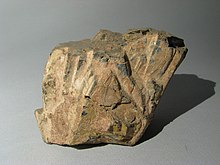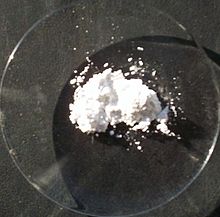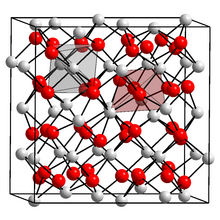Ytterbium
 | ||||||||||||||||||||||||||||||||||||||||||||||||||||||||||||||||||
| Ytterbium | ||||||||||||||||||||||||||||||||||||||||||||||||||||||||||||||||||
|---|---|---|---|---|---|---|---|---|---|---|---|---|---|---|---|---|---|---|---|---|---|---|---|---|---|---|---|---|---|---|---|---|---|---|---|---|---|---|---|---|---|---|---|---|---|---|---|---|---|---|---|---|---|---|---|---|---|---|---|---|---|---|---|---|---|---|
| Pronunciation | /ɪˈtɜːrbiəm/ | |||||||||||||||||||||||||||||||||||||||||||||||||||||||||||||||||
| Appearance | silvery white; with a pale yellow tint[1] | |||||||||||||||||||||||||||||||||||||||||||||||||||||||||||||||||
| Standard atomic weight Ar°(Yb) | ||||||||||||||||||||||||||||||||||||||||||||||||||||||||||||||||||
| Ytterbium in the periodic table | ||||||||||||||||||||||||||||||||||||||||||||||||||||||||||||||||||
| ||||||||||||||||||||||||||||||||||||||||||||||||||||||||||||||||||
kJ/mol | ||||||||||||||||||||||||||||||||||||||||||||||||||||||||||||||||||
| Heat of vaporization | 129 kJ/mol | |||||||||||||||||||||||||||||||||||||||||||||||||||||||||||||||||
| Molar heat capacity | 26.74 J/(mol·K) | |||||||||||||||||||||||||||||||||||||||||||||||||||||||||||||||||
Vapor pressure
| ||||||||||||||||||||||||||||||||||||||||||||||||||||||||||||||||||
| Atomic properties | ||||||||||||||||||||||||||||||||||||||||||||||||||||||||||||||||||
Discovery | Jean Charles Galissard de Marignac (1878) | |||||||||||||||||||||||||||||||||||||||||||||||||||||||||||||||||
| First isolation | Carl Auer von Welsbach (1906) | |||||||||||||||||||||||||||||||||||||||||||||||||||||||||||||||||
| Isotopes of ytterbium | ||||||||||||||||||||||||||||||||||||||||||||||||||||||||||||||||||
| ||||||||||||||||||||||||||||||||||||||||||||||||||||||||||||||||||
Ytterbium is a
In 1878, Swiss chemist
Natural ytterbium is a mixture of seven stable isotopes, which altogether are present at concentrations of 0.3
Characteristics
Physical properties
Ytterbium is a soft,
Ytterbium has three
In contrast with the other rare-earth metals, which usually have
Contrary to most other lanthanides, which have a close-packed hexagonal lattice, ytterbium crystallizes in the face-centered cubic system. Ytterbium has a density of 6.973 g/cm3, which is significantly lower than those of the neighboring lanthanides,
Chemical properties
Ytterbium metal tarnishes slowly in air, taking on a golden or brown hue. Finely dispersed ytterbium readily oxidizes in air and under oxygen. Mixtures of powdered ytterbium with polytetrafluoroethylene or hexachloroethane burn with a luminous emerald-green flame.[14] Ytterbium reacts with hydrogen to form various non-stoichiometric hydrides. Ytterbium dissolves slowly in water, but quickly in acids, liberating hydrogen gas.[11]
Ytterbium is quite
- 2 Yb (s) + 6 H2O (l) → 2 Yb(OH)3 (aq) + 3 H2 (g)
Ytterbium reacts with all the halogens:[15]
- 2 Yb (s) + 3 F2 (g) → 2 YbF3 (s) [white]
- 2 Yb (s) + 3 Cl2 (g) → 2 YbCl3 (s) [white]
- 2 Yb (s) + 3 Br2 (l) → 2 YbBr3 (s) [white]
- 2 Yb (s) + 3 I2 (s) → 2 YbI3 (s) [white]
The ytterbium(III) ion absorbs light in the
- 2 Yb (s) + 3 H2SO4 (aq) + 18 H
2O (l) → 2 [Yb(H2O)9]3+ (aq) + 3 SO2−
4 (aq) + 3 H2 (g)
Yb(II) vs. Yb(III)
Although usually trivalent, ytterbium readily forms divalent compounds. This behavior is unusual for lanthanides, which almost exclusively form compounds with an oxidation state of +3. The +2 state has a valence electron configuration of 4f14 because the fully filled f-shell gives more stability. The yellow-green ytterbium(II) ion is a very strong reducing agent and decomposes water, releasing hydrogen gas, and thus only the colorless ytterbium(III) ion occurs in aqueous solution. Samarium and thulium also behave this way in the +2 state, but europium(II) is stable in aqueous solution. Ytterbium metal behaves similarly to europium metal and the alkaline earth metals, dissolving in ammonia to form blue electride salts.[11]
Isotopes
Natural ytterbium is composed of seven stable
The isotopes of ytterbium range from 149Yb to 187Yb.
Occurrence

Ytterbium is found with other
As an even-numbered lanthanide, in accordance with the
Ytterbium is often the most common substitute in yttrium minerals. In very few known cases/occurrences ytterbium prevails over yttrium, as, e.g., in xenotime-(Yb). A report of native ytterbium from the Moon's regolith is known.[19]
Production
It is relatively difficult to separate ytterbium from other lanthanides due to its similar properties. As a result, the process is somewhat long. First, minerals such as
Ytterbium is separated from other rare earths either by ion exchange or by reduction with sodium amalgam. In the latter method, a buffered acidic solution of trivalent rare earths is treated with molten sodium-mercury alloy, which reduces and dissolves Yb3+. The alloy is treated with hydrochloric acid. The metal is extracted from the solution as oxalate and converted to oxide by heating. The oxide is reduced to metal by heating with lanthanum, aluminium, cerium or zirconium in high vacuum. The metal is purified by sublimation and collected over a condensed plate.[22]
Compounds

The chemical behavior of ytterbium is similar to that of the rest of the lanthanides. Most ytterbium compounds are found in the +3 oxidation state, and its salts in this oxidation state are nearly colorless. Like europium, samarium, and thulium, the trihalides of ytterbium can be reduced to the dihalides by hydrogen, zinc dust, or by the addition of metallic ytterbium.[11] The +2 oxidation state occurs only in solid compounds and reacts in some ways similarly to the alkaline earth metal compounds; for example, ytterbium(II) oxide (YbO) shows the same structure as calcium oxide (CaO).[11]
Halides

Ytterbium forms both dihalides and trihalides with the halogens fluorine, chlorine, bromine, and iodine. The dihalides are susceptible to oxidation to the trihalides at room temperature and disproportionate to the trihalides and metallic ytterbium at high temperature:[11]
Some ytterbium halides are used as
Oxides
Ytterbium reacts with oxygen to form ytterbium(III) oxide (Yb2O3), which crystallizes in the "rare-earth C-type sesquioxide" structure which is related to the fluorite structure with one quarter of the anions removed, leading to ytterbium atoms in two different six coordinate (non-octahedral) environments.[27] Ytterbium(III) oxide can be reduced to ytterbium(II) oxide (YbO) with elemental ytterbium, which crystallizes in the same structure as sodium chloride.[11]
Borides
Ytterbium dodecaboride (YbB12) is a crystalline material that has been studied to understand various electronic and structural properties of many chemically related substances. It is a
History

Ytterbium was
In 1907, the French chemist Georges Urbain separated Marignac's ytterbia into two components: neoytterbia and lutecia. Neoytterbia later became known as the element ytterbium, and lutecia became known as the element lutetium. The Austrian chemist Carl Auer von Welsbach independently isolated these elements from ytterbia at about the same time, but he called them aldebaranium and cassiopeium;[12] the American chemist Charles James also independently isolated these elements at about the same time.[34] Urbain and Welsbach accused each other of publishing results based on the other party.[35][36][37] The Commission on Atomic Mass, consisting of Frank Wigglesworth Clarke, Wilhelm Ostwald, and Georges Urbain, which was then responsible for the attribution of new element names, settled the dispute in 1909 by granting priority to Urbain and adopting his names as official ones, based on the fact that the separation of lutetium from Marignac's ytterbium was first described by Urbain.[35] After Urbain's names were recognized, neoytterbium was reverted to ytterbium.
The chemical and physical properties of ytterbium could not be determined with any precision until 1953, when the first nearly pure ytterbium metal was produced by using
Applications
Source of gamma rays
The 169Yb
High-stability atomic clocks
In 2013, ytterbium clocks held the record for stability with ticks stable to within less than two parts in 1 quintillion (2×10−18).[40] These clocks developed at the National Institute of Standards and Technology (NIST) rely on about 10,000 ytterbium atoms laser-cooled to 10 microkelvin (10 millionths of a degree above absolute zero) and trapped in an optical lattice—a series of pancake-shaped wells made of laser light. Another laser that "ticks" 518 trillion times per second (518 THz) provokes a transition between two energy levels in the atoms. The large number of atoms is key to the clocks' high stability.
Visible light waves oscillate faster than microwaves, hence optical clocks can be more precise than
A pair of experimental atomic clocks based on ytterbium atoms at the National Institute of Standards and Technology has set a record for stability. NIST physicists reported in the August 22, 2013 issue of Science Express that the ytterbium clocks' ticks are stable to within less than two parts in 1
Doping of stainless steel
Ytterbium can also be used as a dopant to help improve the grain refinement, strength, and other mechanical properties of stainless steel. Some ytterbium alloys have rarely been used in dentistry.[9][12]
Ytterbium as dopant of active media
The Yb3+
The kinetic of excitations in ytterbium-doped materials is simple and can be described within the concept of
Usually, low concentrations of ytterbium are used. At high concentrations, the ytterbium-doped materials show photodarkening[50] (glass fibers) or even a switch to broadband emission[51] (crystals and ceramics) instead of efficient laser action. This effect may be related with not only overheating, but also with conditions of charge compensation at high concentrations of ytterbium ions.[52]
Much progress has been made in the power scaling lasers and amplifiers produced with ytterbium (Yb) doped optical fibers. Power levels have increased from the 1 kW regimes due to the advancements in components as well as the Yb-doped fibers. Fabrication of Low NA, Large Mode Area fibers enable achievement of near perfect beam qualities (M2<1.1) at power levels of 1.5 kW to greater than 2 kW at ~1064 nm in a broadband configuration.[53] Ytterbium-doped LMA fibers also have the advantages of a larger mode field diameter, which negates the impacts of nonlinear effects such as stimulated Brillouin scattering and stimulated Raman scattering, which limit the achievement of higher power levels, and provide a distinct advantage over single mode ytterbium-doped fibers.
To achieve even higher power levels in ytterbium-based fiber systems, all factors of the fiber must be considered. These can be achieved only through optimization of all ytterbium fiber parameters, ranging from the core background losses to the geometrical properties, to reduce the splice losses within the cavity. Power scaling also requires optimization of matching passive fibers within the optical cavity.[54] The optimization of the ytterbium-doped glass itself through host glass modification of various dopants also plays a large part in reducing the background loss of the glass, improvements in slope efficiency of the fiber, and improved photodarkening performance, all of which contribute to increased power levels in 1 µm systems.
Ion qubits for quantum computing
The charged ion 171Yb+ is used by multiple academic groups and companies as the trapped-ion qubit for
Others
Ytterbium metal increases its electrical resistivity when subjected to high stresses. This property is used in stress gauges to monitor ground deformations from earthquakes and explosions.[59]
Currently, ytterbium is being investigated as a possible replacement for magnesium in high density pyrotechnic payloads for kinematic infrared decoy flares. As ytterbium(III) oxide has a significantly higher emissivity in the infrared range than magnesium oxide, a higher radiant intensity is obtained with ytterbium-based payloads in comparison to those commonly based on magnesium/Teflon/Viton (MTV).[60]
Precautions
Although ytterbium is fairly stable chemically, it is stored in airtight containers and in an inert atmosphere such as a nitrogen-filled dry box to protect it from air and moisture.
References
- ISBN 978-0-08-037941-8.
- ^ "Standard Atomic Weights: Ytterbium". CIAAW. 2015.
- ISSN 1365-3075.
- ^ ISBN 978-1-62708-155-9.
- .
- PMID 34753931.
- ISBN 0-8493-0464-4.
- ^ .
- ^ ISBN 978-0-8493-0481-1.
- ^ .
- ^ ISBN 978-3-11-007511-3.
- ^ ISBN 978-0-19-850340-8.
- ^ Jackson, M. (2000). "Magnetism of Rare Earth". The IRM quarterly 10(3): 1
- .
- ^ a b c "Chemical reactions of Ytterbium". Webelements. Retrieved 2009-06-06.
- ^ a b "Nucleonica: Universal Nuclide Chart". Nucleonica. 2007–2011. Retrieved July 22, 2011.
- .
- PMID 19776885.
- ^ Hudson Institute of Mineralogy (1993–2018). "Mindat.org". www.mindat.org. Retrieved 7 April 2018.
- S2CID 94642269.
- .
- ISBN 978-0-07-049439-8. Retrieved 2009-06-06.
- PMID 15366881.
- .
- .
- ^ ISBN 978-3-527-30666-4, p. 448.
- ISBN 0-19-855370-6
- S2CID 120575196.
- S2CID 206664739.
- doi:10.1107/S0365110X63003108.)
{{cite journal}}: CS1 maint: numeric names: authors list (link - ^ Weeks, Mary Elvira (1956). The discovery of the elements (6th ed.). Easton, PA: Journal of Chemical Education.
- .
- ^ "Ytterbium". Royal Society of Chemistry. 2020. Retrieved 4 January 2020.
- ^ "Separaton [sic] of Rare Earth Elements by Charles James". National Historic Chemical Landmarks. American Chemical Society. Retrieved 2014-02-21.
- ^ a b Urbain, M.G. (1908). "Un nouvel élément, le lutécium, résultant du dédoublement de l'ytterbium de Marignac". Comptes rendus hebdomadaires des séances de l'Académie des Sciences (in French). 145: 759–762.
- S2CID 101825980.
- S2CID 197766399.
- ^ Hedrick, James B. "Rare-Earth Metals" (PDF). USGS. Retrieved 2009-06-06.
- ISBN 978-0-412-62780-4.
- ^ NIST (2013-08-22) Ytterbium Atomic Clocks Set Record for Stability.
- ^ Peik, Ekkehard (2012-03-01). New "pendulum" for the ytterbium clock. ptb.de.
- ^ "NIST ytterbium atomic clocks set record for stability". Phys.org. August 22, 2013.
- ^ Ostby, Eric (2009). Photonic Whispering-Gallery Resonations in New Environments (PDF) (Thesis). California Institute of Technology. Retrieved 21 December 2012.
- S2CID 250788004.
- .
- ^ McCumber, D.E. (1964). "Einstein Relations Connecting Broadband Emission and Absorption Spectra". Physical Review B. 136 (4A): 954–957. .
- ^ Becker, P.C.; Olson, N.A.; Simpson, J.R. (1999). Erbium-Doped Fiber Amplifiers: Fundamentals and Theory. Academic press.
- .
- .
- S2CID 27830683.
- .
- hdl:10261/46803.
- .
- ^ "Fiber for Fiber Lasers: Matching Active and Passive Fibers Improves Fiber Laser Performance". Laser Focus World. 2012-01-01.
- S2CID 49330988.
- ^ "Quantinuum | Hardware". www.quantinuum.com. Retrieved 2023-05-21.
- ^ "IonQ | Our Trapped Ion Technology". IonQ. Retrieved 2023-05-21.
- S2CID 14424109.
- ISBN 978-0-415-33340-5.
- .
- .
- PMID 807987.
- S2CID 93281866.
- ^ "Material safety data sheet". espi-metals.com. Retrieved 2009-06-06.
Further reading
- Guide to the Elements – Revised Edition, Albert Stwertka, (Oxford University Press; 1998) ISBN 0-19-508083-1
External links
- It's Elemental – Ytterbium
- . Encyclopædia Britannica (11th ed.). 1911.
- Encyclopedia of Geochemistry - Ytterbium
